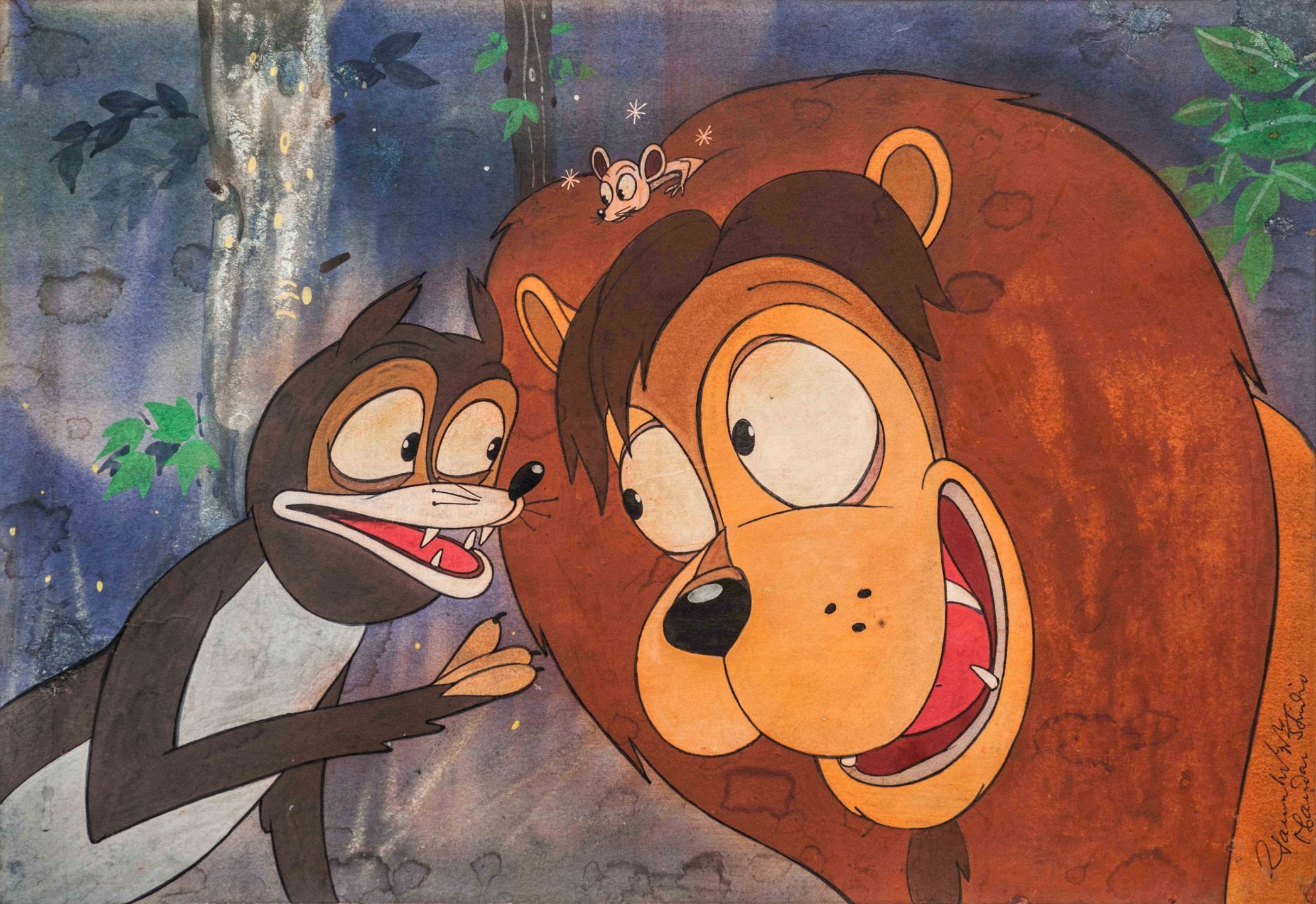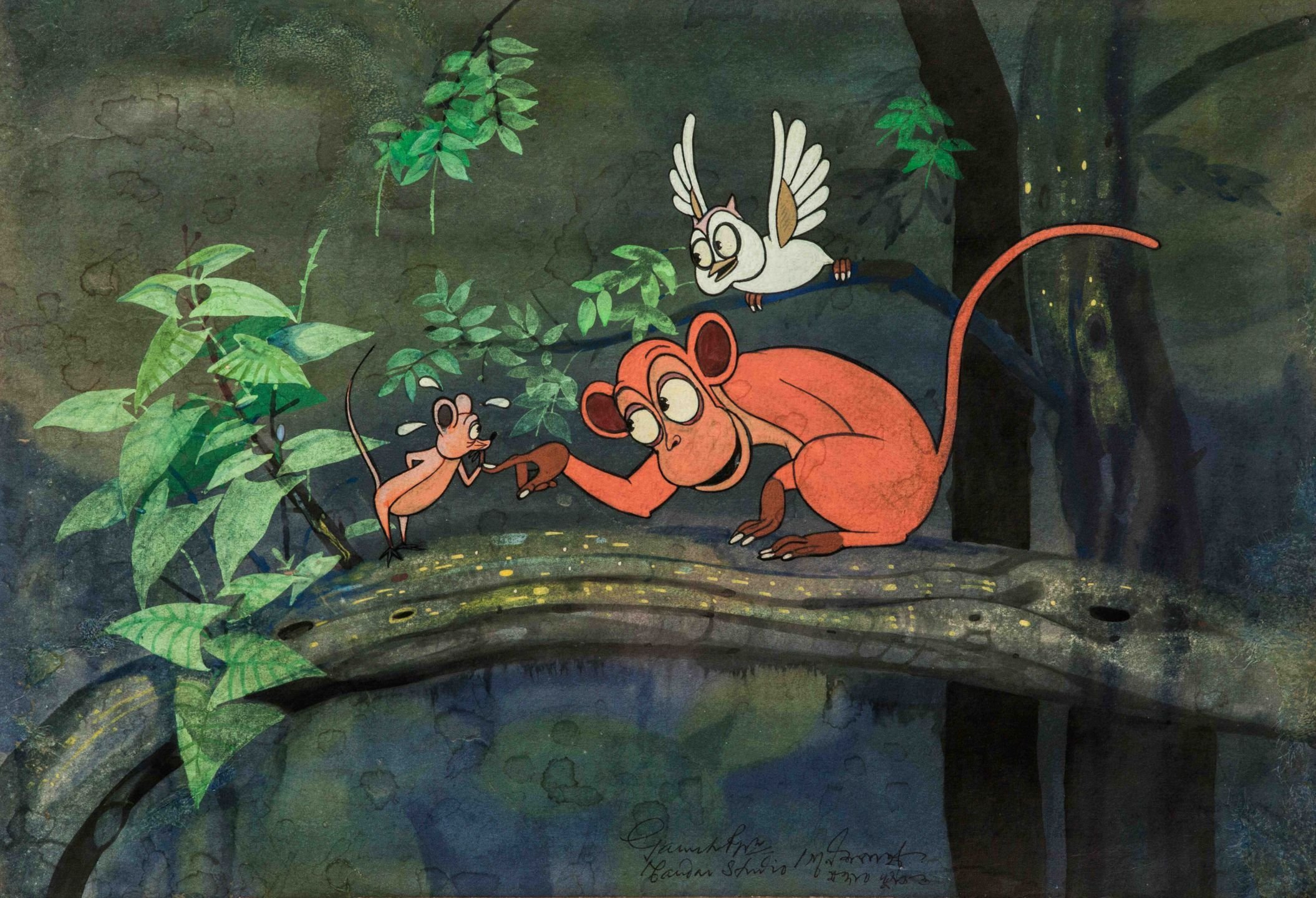
Ganesh Pyne: Mandar Studio Cornwallis Street
January 23 – March 4, 2017 at Akar Prakar, Kolkata
The recent chance-discovery of some artwork, presumably made as components of animation film (of pre-digital software age), by Mandar Mullik’s studio, where Ganesh Pyne worked for earning his living, between the mid-sixties and mid-eighties, brings to fore a so far unknown aspect of the artist’s creative engagement.
Although in a quantitatively major segment of Ganesh Pyne’s oeuvre--representations of nature’s physical features, normally recognised as landscape elements, are verily present, their conglomerations hardly ever appear as natural backgrounds or as sites of painted situations or events. The landscape images of Pyne’s paintings are much more integrated into the totalities or the gestalts of the visual presentations. The landscape imagery in Ganesh Pyne’s work usually are integral parts of elaborate mise en scene--to borrow a term from the realm of cinema.
The recent discoveries, in discussion (as seen in the accompanying reproductions), are an exception to Ganesh Pyne’s so far known, usual use of landscape imagery in painting. These are more genre-specific landscapes. Landscapes without images of living-moving beings and man-made objects. Landscapes of horizontally extended barren expanses of arid undulating land; land with separated-from-each-other rocky outcrops. At long distances can be seen clusters of big trees in forest-like formations. At mid-distances sparsely foliaged shrub-plants stay lonely. Small waterbodies reflecting plants are occasionally found in the foreground.
With emphases on the massey dark shapes of the rocks, undulated contours of the ground, and on the directional linearity of the plant trunks and branches, and above all–on the spatial configuration of images – leaving lots of negative spaces in between, it becomes apparent it is not the description of a landscape but evocation of a feeling of desolation--that is the intention of the artist.
Apart from the chromatic use of dark and sombre to cool tones in masses, sparing linear touches of bright oranges and yellows in tree trunks and branches electrify sensation with their unexpected suddenness. The viewer’s perception reaches further depth with the cognizance of morphological affinity between conglomerations of tree trunks, branches, twigs and skeletal remains of living beings, shining bright in dusky dimness.
Besides this, the other visualinguistic strategy that Ganesh Pyne adopted to divest these landscapes off descriptiveness, is rendering of the images as shade and shadowless forms. Yet, the landscapes do have shadow-forms and reflexion-forms. What distinguishes the shadow-forms and the reflexion-forms are their weightless insubstantiality, due to use of transparent watercolour tints, as against the use of opaque watercolour for object-images. Apart from this technolinguistic tactics, the other visualinguistic strategy that makes these Pyne landscapes enigmatic, is his keeping of the shadow and reflextion sources indeterminate. One looks in vain for the object correlates of the shadows and the reflextions one notices as images, in these landscapes.
These landscapes thus merit to be categorized as imagined landscapes, rather than as experienced locations. These, as if are sites awaiting some happening, rather than as where things have happened. It is quite possible that a set of real life geographic experiences in and around Bengal-Bihar-Odisha border region have had acted as triggers to their creation.
As has already been noted, these landscapes were made as components of animation films. The other major component comprised narratives with anthropomorphized animals, birds and serpent characters. The narratives were illustrative of fables from Hitopodesh and Panchatantra. The stylization of the characters and the visual narration would inevitably follow Walt Disney’s charted course. Ganesh, it seems, wanted to package Indian fables in Disney’s format. Transparent strips with characters painted in opaque watercolour, in narrative sequence, would be manouvered by hand, over landscape backgrounds, for registering on celluloid film-strips, though stop-gate camera, for getting the animation films, clippings of working artwork, of one or two of such films, are being included to give an idea of this facet of Pyne’s works.
By Pranabranjan Ray
Ganesh Pyne | Mixed Media on Paper | 11 x 16.25 in | c.1970
Ganesh Pyne | Mixed Media on Paper | 11 x 16.25 in | c.1970
Ganesh Pyne | Mixed Media on Paper | 11 x 16.25 in | c.1970
Ganesh Pyne | Mixed Media on Paper | 11 x 16.25 in | c.1970
Ganesh Pyne | Mixed Media on Paper | 11 x 16.25 in | c.1970
Ganesh Pyne | Mixed Media on Paper | 11 x 16.25 in | c.1970
Ganesh Pyne | Mixed Media on Paper | 11 x 16.25 in | c.1970
Ganesh Pyne | Mixed Media on Paper | 11 x 16.25 in | c.1970
Ganesh Pyne | Mixed Media on Paper | 11 x 16.25 in | c.1970
Ganesh Pyne | Mixed Media on Paper | 11 x 16.25 in | c.1970
Ganesh Pyne | Mixed Media on Paper | 11 x 16.25 in | c.1970
Ganesh Pyne | Mixed Media on Paper | 11 x 16.25 in | c.1970
Ganesh Pyne | Mixed Media on Paper | 11 x 16.25 in | c.1970
Ganesh Pyne | Mixed Media on Paper | 11 x 16.25 in | c.1970
Ganesh Pyne | Mixed Media on Paper | 11 x 16.25 in | c.1970
Ganesh Pyne | Mixed Media on Paper | 9.25 x 30.5 in | c.1970
Ganesh Pyne | Mixed Media on Paper | 9.5 x 30.5 in | c.1970
Ganesh Pyne | Mixed Media on Paper | 10 x 30.5 in | c.1970
Ganesh Pyne | Mixed Media on Paper | 9.75 x 30.5 in | c.1970
Ganesh Pyne | Mixed Media on Paper | 10 x 30.5 in | c.1970
Ganesh Pyne | Mixed Media on Paper | 10 x 30.5 in | c.1970
Ganesh Pyne | Mixed Media on Paper | 10 x 30.5 in | c.1970
Ganesh Pyne | Mixed Media on Paper | 10.5 x 28 in | c.1970
Ganesh Pyne | Mixed Media on Paper | 11.25 x 29.75 in | c.1970
Ganesh Pyne | Mixed Media on Paper | 11.25 x 29.75 in | c.1970
Ganesh Pyne
Ganesh Pyne, an Indian painter and draughtsman, was born in Calcutta in 1937. An introverted child, Pyne began sketching and doodling right from his childhood. Born and brought up in Calcutta, living in a crumbling family mansion in Kabiraj Row, north Calcutta, Pyne grew up listening to his grandmother’s folktales and reading fantasy stories from children’s books, which was to create the vocabulary of his future art. During his childhood years, he also flipped through Mouchak, a Bengali children’s magazine, to which his family subscribed to. In the magazine, he came across a printed drawing by Abanindranath Tagore, the founder of the Bengal school art movement, which had a deep impact on him. Thereafter he started reading avidly and drawing on the slate with chalk for hours. In 1946, he lost his father; and following the Calcutta riots, which preceded India’s partition, his family moved to a safe zone at the Calcutta Medical College. The trauma at the age of 9 had a lasting impact on his life and work.
After finishing school, he joined the Government College of Art & Craft in Calcutta. In 1959, he received his diploma in drawing and painting. Later, Pyne developed his own style of “poetic surrealism”, fantasy and dark imagery, around the themes of Bengali folklore and mythology. After graduating from art college, Pyne decided against taking up a full-time job and commenced his artistic career in the early 1960s as a book illustrator and a sketch artist for animation films at Mandar Mullick’s studio in Calcutta. In 1963, he became a member of the newly-formed Society of Contemporary Artists. His early work was deeply influenced by the Bengal school, especially Abanindranath Tagore, who was a major influence in watercolour. For the painter, the 1970s was an important period, when he moved to watercolours. The tumultuous period of anger and despair in Bengal found expression in his art. Pyne started as a watercolourist in the Bengal-school mode, and gradually shifted to gouache and tempera for his subsequent abstract and surrealist work in ochre, black and blue shades.
Ganesh Pyne is well known for his small-scale works in tempera on canvas, watercolour on paper and gouache. He also painted microcosmic images and motifs from the world of Bengali fables and fairy tales, including the Thakumar Jhuli and similar sources like the music and lyrics of Baul singers.
























